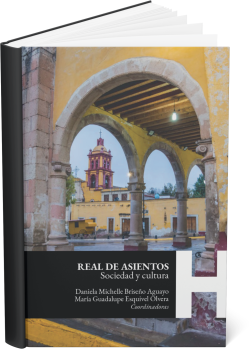REAL DE ASIENTOS: Society and culture
Synopsis
Asientos de Ibarra, as we know, was founded before the villa of Aguascalientes, within the first stage of the conquest and colonization of what would become the kingdom of Nueva Galicia. An asiento implied the privilege granted to the conquerors and encomenderos; however, starting from the New Laws of 1542, these privileges would be limited just like the feudal dreams of the war captains, a process that, despite various reforms, would extend well into the 17th century. Then, the town that would bring life to the Real de Minas in the 18th century would slowly develop, which in turn would be the origin of the municipality we now know as Asientos.
The nine chapters that make up this important book were written by historians who cultivate the discipline from various branches such as demography, art, written culture, religion, and education; and intersect with dimensions such as memory, identity, and literature. The works draw on various explanatory frameworks and methodological strategies, resort to relevant documentary sources, but have in common that they converge on regional history and focus on the town of Asientos, Aguascalientes.
Francisco Antonio Aguilar Irepan begins; in "Origin of the First Settlers of the Real de Minas de Asientos, 1697-1720," he provides a well-documented text to account for the first mining settlers, the pioneers, both mine owners and tenants, who settled in the region to discover deposits, extract metals, and process them, but he also speaks to tasks related to this predominant economic activity. In that vein, María Guadalupe Esquivel Olvera also makes use of birth, baptism, marriage, and death records. In her chapter, "Population Dynamics of the Parish of Our Lady of Bethlehem, 1705-1800," the author examines, in a demographic study, the period of growth and consolidation over nearly a century.
With the tools of art history, and paying attention to the world of symbolism, religious meanings, and artistic styles, Daniela Michelle Briseño Aguayo, in the chapter "Notes on the Construction of the Parish of Our Lady of Bethlehem and Some of the Changes Occurred Over the Centuries," makes a temporal sweep that allows for the reconstruction of fundamental moments in the stages when the most important religious site in Asientos was being built. For her part, and continuing with the same theme, María Guadalupe Rodríguez López, supported by highly specialized recent bibliography and primary sources (historical archives of the Diocese of Aguascalientes and the Archdiocese of Guadalajara, mainly), in her text, "The Erection of the Parish of Our Lady of Bethlehem in Asientos, 1731," offers a broad perspective – taking into account the cases of the dioceses of Puebla, Oaxaca, Michoacán, and, of course, Guadalajara, which shows us, step by step, the process of erecting the new parish.
On another note, we have the very interesting work of Luis Arturo Sosa Barrón, "The Guadalupe Cemetery of the former mining town of Asientos." Brief notes on its historical development, 1767-1867,” who, after making a historiographical assessment on the subject and focusing on the moments, steps, or elements that make up the Catholic funeral ritual, refutes a series of versions he considers erroneous regarding the antiquity of the site, funeral practices, and some assertions. On the same point, but with great sensitivity and extensive knowledge of sepulchral art, she demonstrates her expertise to Lourdes Adriana Paredes Quiroz in her text "The Eschatological Iconography of the Portico of the Camposanto de Guadalupe in Real de Asientos, Aguascalientes," in which she addresses the study of the mural paintings carried out on three walls, around the mid-19th century, with motifs on the triumph of death Context: Lourdes Adriana Paredes Quiroz in her text "The Eschatological Iconography of the Portico of the Camposanto de Guadalupe in Real de Asientos, Aguascalientes," in which she addresses the study of the mural paintings carried out on three walls, around the mid-19th century, with motifs on the triumph of death.
Text to translate: .
On the other hand, Lucas Martínez Sánchez took advantage of a guided tour of the magical town of Asientos in 2010 to share his impressions regarding the parish, the tunnels, the art gallery, its streets and emblematic houses, as well as the Temple of Guadalupe, and then provided us with a meticulous bibliographic and documentary research. To better understand "Rural Education in Asientos between the years 1920 and 1923." The cases of Ciénega Grande, Guadalupe de Atlas, and El Mezquite," Laura Olvera Trejo provides us with a background overview of the educational landscape in the tumultuous 19th century, with an emphasis on the periods of the Restored Republic and the Porfirio Díaz era, to establish that it was during the first four years of the post-revolution that firm steps were taken to bring education to broad sectors of the population across the country. It concludes with a flourish the chapter "Harriet Doerr and her Stones for Ibarra." A tribute to Asientos, Aguascalientes," by Marcela López Arellano, who tells us the fascinating story behind and around this wonderful fictional memoir.
The authors who contributed to this work prove that regional history, matria history, microhistory, or whatever you want to call it, is more alive than ever and is well worth continuing to invest in.
Chapters
-
Acknowledgments
-
Presentation
-
Foreword
-
REAL DE ASIENTOS FROM HISTORY
-
Origin of the first settlers of the Real de Minas de Asientos, 1697-1720
-
Population dynamics of the Parish of Our Lady of Bethlehem, 1705-1800
-
Notes on the construction of the Parish of Our Lady of Bethlehem and some of the changes that have occurred over the centuries
-
The erection of the Parish of Our Lady of Bethlehem in Asientos, 1731
-
The Guadalupe Cemetery of the old Real de Minas de Asientos. Brief notes on its historical development, 1763-1867
-
The eschatological iconography of the portico of the Camposanto of Guadalupe del Real de Asientos, Aguascalientes
-
An ancient Franciscan presence in Real de Asientos, Aguascalientes
-
Rural education in Asientos between 1920 and 1923: the cases of Ciénega Grande, Guadalupe de Atlas, and El Mezquite
-
Harriet Doerr and her Stones for Ibarra. A tribute to Asientos, Aguascalientes

Downloads
Published
Series
Categories
License

This work is licensed under a Creative Commons Attribution-ShareAlike 4.0 International License.













